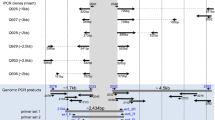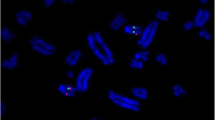Abstract
We isolated major histocompatibility complex class II B (MHCIIB) genes in the Barn owl (Tyto alba). A PCR-based approach combined with primer walking on genomic and complementary DNA as well as Southern blot analyses revealed the presence of two MHCIIB genes, both being expressed in spleen, liver, and blood. Characteristic structural features of MHCIIB genes as well as their expression and high non-synonymous substitution rates in the region involved in antigen binding suggest that both genes are functional. MHC organization in the Barn owl is simple compared to passerine species that show multiple duplications, and resembles the minimal essential MHC of chicken.




Similar content being viewed by others
References
Alcaide M, Edwards S, Negro J (2007) Characterization, polymorphism, and evolution of MHC Class II B genes in birds of prey. J Mol Evol 65:541–554
Brown JH, Jardetzky TS, Gorga JC, Stern LJ, Urban RG, Strominger JL et al (1993) Three-dimensional structure of the human class II histocompatibility antigen HLA-DR1. Nature 364:33–39
Burri R, Niculita-Hirzel H, Salamin N, Roulin A, Fumagalli L (2008) Evolutionary patterns of MHC class II B in owls and their implications for the understanding of avian MHC evolution. Mol Biol Evol 25:1180–1191
Del Hoyo J, Elliott A, Sargatal J (2000) Barn owls to hummingbirds. Handbook of the birds of the world. Lynx Editions, Barcelona, p 759
Doherty PC, Zinkernagel RM (1975) Enhanced immunological surveillance in mice heterozygous at the H-2 gene complex. Nature 256:50–52
Edwards S, Gasper J, March M (1998) Genomics and polymorphism of Agph-DAB1, an Mhc class II B gene in red-winged blackbirds (Agelaius phoeniceus). Mol Biol Evol 15:236–250
Ekblom R, Grahn M, Höglund J (2003) Patterns of polymorphism in the MHC class II of a non-passerine bird, the great snipe (Gallinago media). Immunogenetics 54:734–741
Excoffier L, Laval G, Schneider S (2005) Arlequin (version 3.0): an integrated software for population genetics data analysis. Evol Bioinformatics 1:47–50
Hanada K, Shiu S-H, Li W-H (2007) The nonsynonymous/synonymous substitution rate ratio versus the radical/conservative replacement rate ratio in the evolution of mammalian genes. Mol Biol Evol 24:2235–2241
Hess CM, Edwards SV (2002) The evolution of the major histocompatibility complex in birds. Bioscience 52:423–431
Hofmann K, Stoffel W (1993) TMbase—a database of membrane spanning proteins segments. Biol Chem Hoppe Seyler 374:166
Kall L, Krogh A, Sonnhammer ELL (2004) A combined transmembrane topology and signal peptide prediction method. J Mol Biol 338:1027–1036
Kaufman J, Milne S, Gobel TWF, Walker BA, Jacob JP, Auffray C et al (1999) The chicken B locus is a minimal essential major histocompatibility complex. Nature 401:923–925
Kaufman J, Salomonsen J, Flajnik M (1994) Evolutionary conservation of MHC class I and class II molecules—different yet the same. Semin Immunol 6:411–424
Klein J, Bontrop R, Dawkins RL, Erlich HA, Gyllensten UB, Heise ER et al (1990) Nomenclature for major histocompatibility complexes of different species: a proposal. Immunogenetics 31:217–219
Marchler-Bauer A, Bryant SH (2004) CD-Search: protein domain annotations on the fly. Nucleic Acids Res 32:W327–W331
Milinski M (2006) The major histocompatibility complex, sexual selection, and mate choice. Annu Rev Ecol Evol Syst 37:159–186
Nielsen R, Yang Z (1998) Likelihood models for detecting positively selected amino acid sites and applications to the HIV-1 envelope gene. Genetics 148:929–936
Penn DJ, Damjanovich K, Potts WK (2002) MHC heterozygosity confers a selective advantage against multiple-strain infections. Proc Natl Acad Sci USA 99:11260–11264
Piertney SB, Oliver MK (2006) The evolutionary ecology of the major histocompatibility complex. Heredity 96:7–21
Robinson J, Waller MJ, Parham P, de Groot N, Bontrop R, Kennedy LJ et al (2003) IMGT/HLA and IMGT/MHC: sequence databases for the study of the major histocompatibility complex. Nucleic Acids Res 31:311–314
Roulin A (1999) Nonrandom pairing by male Barn owls (Tyto alba) with respect to a female plumage trait. Behav Ecol 10:688–695
Roulin A, Ducrest A-L, Balloux F, Dijkstra C, Riols C (2003) A female melanin ornament signals offspring fluctuating asymmetry in the Barn owl. P Roy Soc B-Biol Sci 270:167–171
Roulin A, Riols C, Dijkstra C, Ducrest A-L (2001) Female plumage spottiness signals parasite resistance in the Barn owl (Tyto alba). Behav Ecol 12:103–110
Schultz J, Milpetz F, Bork P, Ponting CP (1998) SMART, a simple modular architecture research tool: identification of signaling domains. Proc Natl Acad Sci USA 95:5857–5864
Takahata N, Nei M (1990) Allelic genealogy under overdominant and frequency-dependent selection and polymorphism of major histocompatibility complex loci. Genetics 124:967–978
Tong JC, Bramson J, Kanduc D, Chow S, Sinha AA, Ranganathan S (2006) Modeling the bound conformation of Pemphigus vulgaris-associated peptides to MHC class II DR and DQ alleles. Immunome Res 2:1
Tsuda T, Tsuda M, Naruse T, Kawata H, Ando A, Shiina T et al (2001) Phylogenetic analysis of penguin (Spheniscidae) species based on sequence variation in MHC class II genes. Immunogenetics 53:712–716
Wagner A, Blackstone N, Cartwright P, Dick M, Misof B, Snow P et al (1994) Surveys of gene families using polymerase chain reaction: PCR selection and PCR drift. Syst Biol 43:250–261
Wang J-H, Meijers R, Xiong Y, Liu J-h, Sakihama T, Zhang R et al (2001) Crystal structure of the human CD4 N-terminal two-domain fragment complexed to a class II MHC molecule. Proc Natl Acad Sci USA 98:10799–10804
Wittzel H, von Schantz T, Zoorob R, Auffray C (1994) Molecular characterization of three Mhc class II B haplotypes in the ring-necked pheasant. Immunogenetics 39:395–403
Yang Z, Nielsen R (2000) Estimating synonymous and nonsynonymous substitution rates under realistic evolutionary models. Mol Biol Evol 17:32–43
Zelano B, Edwards SV (2002) An Mhc component to kin recognition and mate choice in birds: predictions, progress, and prospects. Am Nat 160:S225–S237
Zoorob R, Béhar G, Kroemer G, Auffray C (1990) Organisation of a functional chicken class II B gene. Immunogenetics 31:179–187
Acknowledgements
We thank Catherine Berney for technical assistance in the lab, Anne-Lyse Ducrest for helpful discussions, Philippe Christe for providing samples, and two anonymous reviewers for helpful comments on earlier versions of the manuscript. The study was supported by the Swiss National Science Foundation grants 3100A0-109852/1 to LF and PP00A-102913 to AR.
Author information
Authors and Affiliations
Corresponding author
Additional information
Data deposition: Nucleotide sequence data reported in this paper have been deposited in the GenBank database and have accession numbers EU442602–EU442607.
Electronic supplementary material
Below is the link to the electronic supplementary material.
Figure S1
Nucleotide sequence alignment of Barn owl the genomic MHCIIB sequences with sequences of Strigidae and Accipitridae (Alcaide et al. 2007), Humboldt’s penguin (Spheniscus humboldti, accession no. AB154394) and Great snipe (Gallinago media, accession no. AF485404) (Ekblom et al. 2003). The black bar highlights exons, the grey bar the introns. (JPEG 44.4 MB)
Table S1
Primers used in primer walking on genomic and complementary DNA. (29.5 KB)
Rights and permissions
About this article
Cite this article
Burri, R., Niculita-Hirzel, H., Roulin, A. et al. Isolation and characterization of major histocompatibility complex (MHC) class II B genes in the Barn owl (Aves: Tyto alba). Immunogenetics 60, 543–550 (2008). https://doi.org/10.1007/s00251-008-0308-0
Received:
Accepted:
Published:
Issue Date:
DOI: https://doi.org/10.1007/s00251-008-0308-0




